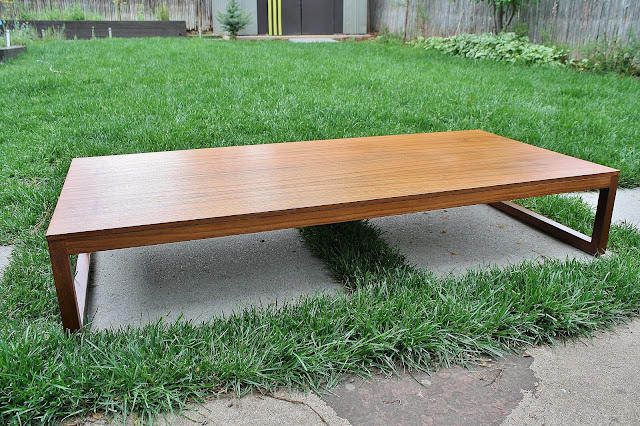Life (and vintage furniture) is full of little surprises. I've had this piece in my garage for over 2 years. When I first acquired it, I didn't pay much attention to what it was made of. It was dark brown, I assumed it was walnut, the design was interesting, I loaded into the car. It didn't take long to realize it wasn't walnut. The case and drawer fronts are all Pecan. Pecan is considered the same as Hickory in woodworking terms, Pecan is the fruit-bearing variety of Hickory. Hickory and Pecan are very strong, sturdy woods that are great to make furniture from. However, they are not as easy to finish and give them a "modern" look. With clear finishes they tend to look very yellow and "rustic". They do sometimes have interesting grain patterns and color variation. I knew if I just stained them, that variation would disappear. With all the pieces I do I try to use a finish process that takes advantage of the inherent qualities of the particular material. Walnut, Rosewood and Teak are no-brainers. Their natural coloring makes them beautiful by themselves. Less-is more is the right approach for those. Pecan was going to take something else.
I finally decided to pull this piece out and start working on it. My next surprise was that the decorative "carvings" on the front could be removed and, they were plastic. This would make the prep easier but eliminate the possibility of staining them. I was starting to get some ideas on the design direction I would take. The next surprise came when I removed the carvings. They revealed that the fronts of the doors were a veneer patchwork of burled wood! Being a materials kinda guy this was like finding a pot of gold. Burled woods are incredibly beautiful with their swirly grain and coloring.
Now I was going to have to try to find a way to visually tie the painted carvings and the burl to the pecan. Contrasting the burl with the surrounding materials would really put the focus on the burl, but I didn't want to just paint everything else and wanted to show the grain variation in the pecan. I was lucky enough to have an old pecan end table that I got with some other pieces. It didn't have much design interest so I decided to use it as a finish test piece. After playing around with a number of techniques and finishes I came up with a process that gave the Pecan a bleached look and still showed the grain. Painting the case edge and carvings white would enhance the bleached Pecan and offer the needed contrast for the burl. The results are what you see below.
A couple of year ago Stanley Furniture released their "Heritage Collection" at the High Point Market trade show. Stanley acquired a number of their mid-century pieces and restored them at their factory. Among them was a "Theme II" credenza. The designers at Stanley choose to paint the entire doors and carvings white and finished the case in a contrasting brown. It is a handsome combination but I have a hard time knowing that under the white paint is beautiful burl veneer work. The collection was very well received and sold almost immediately. Pricing on the case pieces was $2000-$6000.
http://www.virtuelreel.com/restored-vintage-stanley-furniture-heritage-collection-an-interview-with-randy-wells-22-photos
Here are a couple articles with copies of the original catalogs. In the description they offered a finish named "Maltese" which was "like that of a frosted blue mink". I have not been able to find any pictures of this finish. Perhaps mine is a modern interpretation.
http://www.justinteriorideas.com/vintage-stanley-furnishings-topic-ii-line-10-web-page-catalog-from-the-firm39s-archives-retro.html
http://retrorenovation.com/2014/03/12/vintage-stanley-furniture-theme-ii-line-10-page-catalog-companys-archives/
The "Cosmopolitan" dresser has 6 large drawers behind the 4 doors.
Dimensions: 72 5/8"W x 31"H x 19"D
sold
I'm not normally good at taking before pics, but as I discovered the burl, I snapped these photos. Note the original muddy brown color with "wormwood" effect.




































